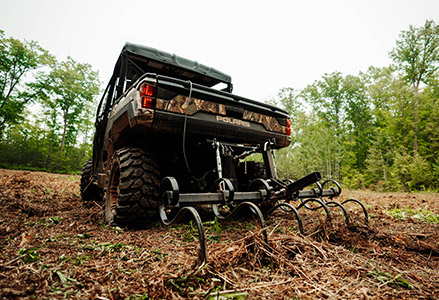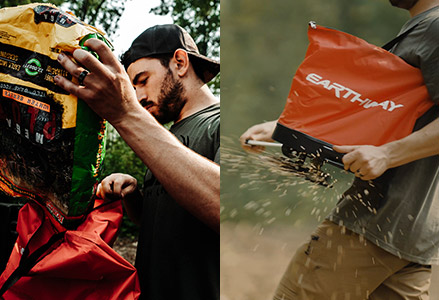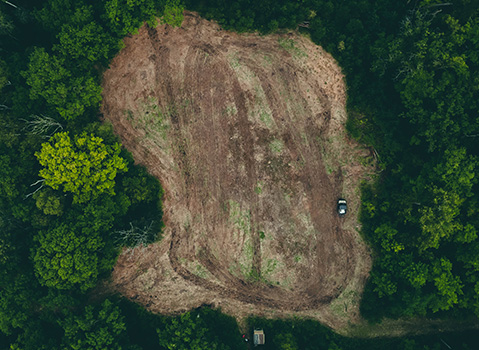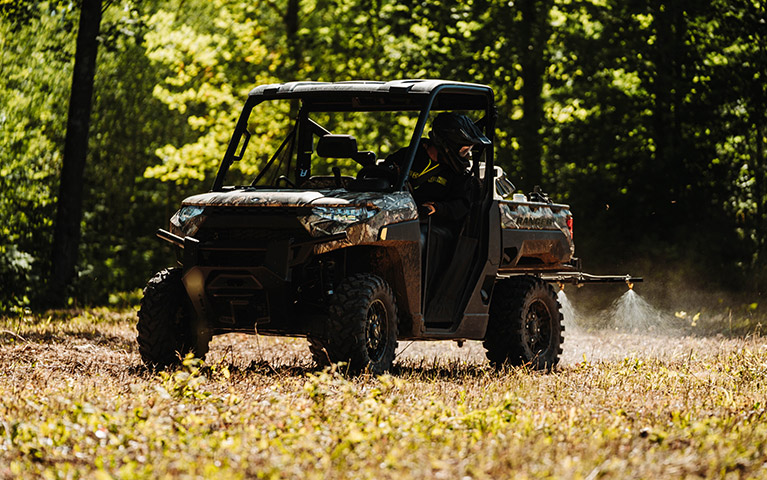
How to Plant a Food Plot
Created in partnership with Pat Reeve—host of Driven TV and one of the top hunting authorities on whitetail deer.
Adding a food plot to your land can be an extremely rewarding experience. Not only can it help improve your chances of harvesting a deer during the next hunting season, it can also turn a sport you love into a year-round activity. Creating a food plot can be hard work, but seeing the ground transform before your eyes, the plants take hold and flourish, and the deer habits begin to change…well, that’s a powerful feeling.
How to Select a Food Plot Location
If you don’t already have a spot picked out for your food plot, the location you choose will be important. You’ll want to find a natural clearing on your property if you can. It will be easier to prep and will offer natural cover nearby for the deer. Be sure to consider any deer trails in the area, if there is drinking water in the vicinity and whether you’ll need to provide irrigation to your new plants. All of this will factor into choosing the ideal food plot location.
To learn more about choosing a location for a food plot or the tools for clearing the land, check out this article on How To Develop Land for Deer Hunting >

Tilling vs. No Tilling
Prepping the soil to plant is an important step in starting everything off on the right foot. There are a couple of ways you can go about this. Traditional tilling, using a cultivator, loosens up hard-packed soil, can help control weeds, and gives you a chance to mix organic matter into the soil. Plant in tilled soil using a hand seeder, push spreader, or pull-behind UTV or ATV spreader for larger plots.
If you have access to ag machinery, you can go the no-till route. This method involves drilling holes in the ground that the seeds are dropped into. No tilling requires less fertilizer because it helps retain existing organic matter already in the soil, and it promotes nutrient cycling. It is also ideal for places that might have issues with erosion.

Best Time of Year To Plant a Food Plot
When you plant will depend on what you decide to plant in your food plot. There are basically two times of the year you’ll want to be out in your food plot getting seeds in the ground to ensure the plants are ready to eat at the right time. Early spring is best if you are planting greens and grains. If you’re planning on supplementing with brassicas or sugar beets, they will need to go in the ground in late July or early August. Watch the weather and try to plant before a nice soaking rain to promote plant establishment.
What to Plant In Your Food Plot to Attract Deer All Year Round
Greens planted in the spring will be the first to grow, providing a quick food source for deer. This includes clover and alfalfa, which give deer something to graze on in early spring. Grains, such as corn and soybeans, need about 100 days of growing in warm soil conditions to provide food the deer will eat from late summer into fall. Sugar beets, chicory and brassicas (like turnips) are best planted in late July to early August—providing a late season food source.

Fertilizing Your Food Plot: What to Use & When
One of the best ways to ensure a healthy, robust crop is to lay down some fertilizer. While fertilizer is an added expense, it can produce big results, helping your plants grow more vigorously. Apply while planting to give new plants a boost, and again during the growing season if you notice some weakening in your growth. Don't skip this step. You've already gone to the effort of clearing the land, prepping for planting and laying seed. Fertilizer will ensure that all that work is worthwhile and comes to fruition.
Consider a 19-19-19 mix. It contains 19% nitrogen, 19% phosphorous, and 19% potassium that are ideal for strong growth. Just like seeding, it can be applied using a hand spreader, push spreader or pull-behind UTV or ATV spreader to make quick work of this task, especially on larger plots. You’ll want good coverage, but not too much or you’ll risk burning your crops. Refer to fertilization charts on the fertilizer packaging to help determine how much to apply, and set your spreader rates accordingly.

Recommended Equipment for Planting Your Food Plot
Like any task, having the right tools on hand can make a tough job easy. The right vehicle and the right accessories will make planting, fertilizing and maintaining your food plot an enjoyable experience with great results.
Use An Off-Road Vehicle
As with all phases of hunting and hunting prep, a UTV or ATV is a great tool to have available. It will provide easy access to your food plot, especially if it’s remote, and can help with tilling, seeding and fertilizing—saving you time and minimizing effort.
Accessories to Have on Hand
Think about what you’ll need to prep the soil, plant it and take care of your crops. Here are just a few items you might want to consider.
-
-
Pull Behind ATV or UTV Cultivator—helps with the initial preparation of hard-packed soil.
-
Pull Behind ATV or UTV Disc Plow—makes quick work of tilling the soil to get it ready for planting.
-
Spreaders—use a hand or push spreader for small plots, or an ATV/UTV pull-behind spreader for larger plots.
-

Watering Your Food Plot: How Much & How Often
Depending on where you live, you might get enough rain in the summer where watering your food plot is not a big concern. But in some locations, or during periods of dryness, you can’t always count on Mother Nature to supply the moisture. In these instances, you might need to hook up sprinklers or add an irrigation system off a well.
Keep in mind, if you live in an area where water is an issue, you may want to position your food plot where you have convenient access to water. The rate at which you water will depend on how often the area gets natural rainfall. Keep an eye on local rainfall amounts and water when the crops start showing stress.


Using a sprayer attached to your ATV or UTV won’t be enough to give your plants the good soaking they need. Consider other methods of watering, such as sprinklers.

Next Steps After Planting Your Food Plot
Once you’ve established your food plot and the crops have started to grow, you’ll want to turn your attention to things like maintaining, and maybe even adjusting your food plot. Keep an eye on deer habits—what they’re eating and how often. You can use trail cams to monitor their behavior and start making plans for the best places for your stand or blind.







